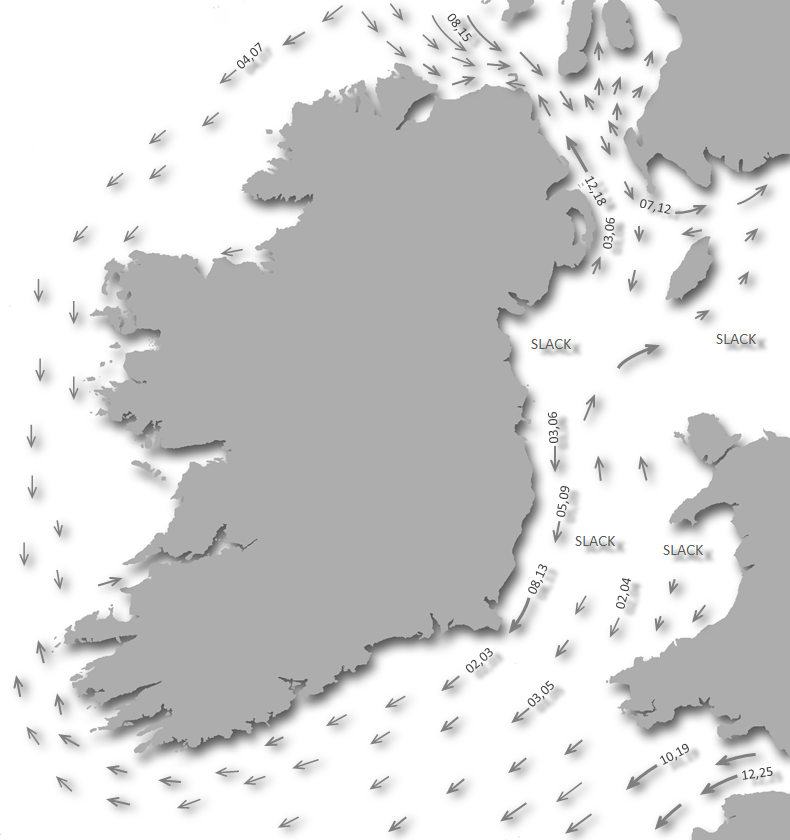

Attentive navigation is required and it affords tolerable shelter.
Keyfacts for Inishmurray
Facilities
None listedNature






Considerations

Protected sectors
Approaches


Shelter


Last modified
May 30th 2017 Summary
A tolerable location with attentive navigation required for access.Facilities
None listedNature






Considerations

Position and approaches
Expand to new tab or fullscreen
Haven position
 54° 25.796' N, 008° 39.695' W
54° 25.796' N, 008° 39.695' Wthis is the position of Inishmurray quay.
What is the initial fix?
The following Inishmurray initial fix. will set up a final approach:
 54° 23.960' N, 008° 40.020' W
54° 23.960' N, 008° 40.020' W Not what you need?
Click the 'Next' and 'Previous' buttons to progress through neighbouring havens in a coastal 'clockwise' or 'anti-clockwise' sequence. Below are the ten nearest havens to Inishmurray for your convenience.
Ten nearest havens by straight line charted distance and bearing:
- Brown Bay - 5.9 nautical miles S
- Mullaghmore - 7.8 nautical miles ENE
- Rosses Point - 8.2 nautical miles SSE
- Aughris Hole - 10 nautical miles SSW
- Ballysadare Bay - 11 nautical miles SSE
- Sligo - 11.3 nautical miles SE
- Teelin - 11.7 nautical miles N
- Killybegs - 14.5 nautical miles NNE
- White Strand Bay - 14.5 nautical miles NNW
- Malin Beg Bay - 14.7 nautical miles NNW
These havens are ordered by straight line charted distance and bearing, and can be reordered by compass direction or coastal sequence:
- Brown Bay - 5.9 miles S
- Mullaghmore - 7.8 miles ENE
- Rosses Point - 8.2 miles SSE
- Aughris Hole - 10 miles SSW
- Ballysadare Bay - 11 miles SSE
- Sligo - 11.3 miles SE
- Teelin - 11.7 miles N
- Killybegs - 14.5 miles NNE
- White Strand Bay - 14.5 miles NNW
- Malin Beg Bay - 14.7 miles NNW
Chart
How to get in?
 The 'Erris Head to Malin Head' coastal description provides approach information to the suggested initial fix. Vessels approaching from the south should select the northeast bound
The 'Erris Head to Malin Head' coastal description provides approach information to the suggested initial fix. Vessels approaching from the south should select the northeast bound  sequenced description; vessels approaching from the north should select the southwest bound
sequenced description; vessels approaching from the north should select the southwest bound  sequence; western approaches may use either description.
sequence; western approaches may use either description.Inishmurray island is situated between Sligo Bay and Donegal Bay, 4 miles north of Ballyconnell Point and 7 miles southwest of Mullaghmore Head, in the North Atlantic Ocean in County Sligo on the west coast of Ireland.
From Sligo Bay to Mullaghmore Head the coast should be given a wide berth in any height of sea from the west. A course halfway between the shore on the mainland and Inishmurray is a safe one. Along this coast a good lookout should be kept for lobster pots which are often set very far out.
With any sea or at low water, caution should be taken to avoid the shoal patches close to the east and northeast of the island. Also Bomore Rock and its outliers 1.5 miles north of the island must be given a wide berth.
Clashymore Harbour is a rocky gut on the south side of the island, off which in calm weather only a yacht may be anchored in a depth of 7 metres in weed over rock, and where it is advisable to have a trip line on the anchor. On the east side of the gut there are natural quays and mooring rings where local boats go alongside at high water, which also provides a good spot for a dinghy landing that becomes more difficult at low water. Landing can be difficult even at the quay which is not very sheltered and distinctly open to the southeast.
Landing can also be had onto rocks further west on the south side of the island in the often more sheltered deeply indented coves west of the village. This spot though sheltered is suitable for dinghies that can be tethered or anchored, and then hop or step onto the rocks or slabs.
Why visit here?
Located about 3 miles west off Streedagh Point on the mainland coast, Inishmurray is a lovely remote island with an interesting history both ancient and recent. In suitable weather conditions it is well worth a visit to see the remarkable collection of unusually well preserved 6th century monastic buildings, which were built on the site of an original pagan fort.This ruined settlement founded by Columba is inside a Bronze Age fortification the walls of which were once 4.5 metres high but now only half that. The enclosure of cells, bee-hives, churches, altars, and carved stones, which make the island a must for visit, are in better condition after 1400 years than the village houses after 100. The menfolk of the island were buried inside the enclosure and the women outside, 150 metres away at Teampalnamban.
The island was pagan until Columba built a new monastery inside the fort and installed St. Molaise as Abbot. Almost immediately the monastery gained fame, and on a visit back Columba borrowed a book from the library and without telling the Abbot he copied it. Molaise was furious and demanded the return of the copy. Denied, he appealed to Diarmuid the High King, who was then like the Supreme Court is today. His judgement was “to every cow its calf, to every book its copy”, which was probably the first copyright decision in Western Europe. Worse was to come, Columba still wouldn't return the copy, and Diarmuid feeling that he was being challenged, set out westwards with an army 3,000 strong to punish Columba and his followers. Columba was resoundingly beaten outside Sligo with the loss of all his men, and he was so upset by the unanticipated consequences of his thievery that he relented and presented himself to Molaise in confession. As penance Molaise banished Columba to Scotland, never to return until he had converted to Christianity as many as the 3,000 killed in the battle. Columba sailed and landed at Iona and there founded his greatest ever monastery, never to return to Ireland.
Inishmurray was infamous for the making of poitin. There being no easy landing point on the island, visits by the authorities were few. This enabled the islanders to distill the best illicit whiskey in the country, marketed as “Old Inishmurray”. When the Revenue officials did come they had to hire boats locally, and word soon got round to the islanders that they were about to receive a visit. Forewarned by the time the Revenue officials got ashore the illicit brew was well hidden and prosecutions avoided.
The islanders of Inishmurray were renowned for a combined rowing/sailing technique unique in Ireland, which made them the safest, fastest and bravest sailors around.
In 1915 a British warship mistook the island for a submarine, and torpedoed it. It was thought that the old fort was mistaken for a conning tower. None of the islanders were hurt.
There are no facilities on the island, but it is well worth a visit to sailors if on passage from Aughris Head to Rathlin O'Birne.
What facilities are available?
There are no facilities at this location.With thanks to:
inyourfootsteps.com site research.



The following video presents an excellent view of entering Clashymore, the anchorage at Inishmurray by fishing boat.
Add your review or comment:
Please log in to leave a review of this haven.
Please note eOceanic makes no guarantee of the validity of this information, we have not visited this haven and do not have first-hand experience to qualify the data. Although the contributors are vetted by peer review as practised authorities, they are in no way, whatsoever, responsible for the accuracy of their contributions. It is essential that you thoroughly check the accuracy and suitability for your vessel of any waypoints offered in any context plus the precision of your GPS. Any data provided on this page is entirely used at your own risk and you must read our legal page if you view data on this site. Free to use sea charts courtesy of Navionics.












